|
|
Welcome to my travel log! You will find here a lot more than in the travel reports, stripped from political correctness. Enjoy! 
Oct 07, 2006 02:00 PM Jodhpur (Rajasthan)
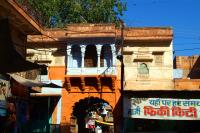 The flight to Jodhpur was boring and uneventful. I kept my window blind down as it was very hot and the air conditioning could not cope. Other than it was slightly late, I would have nothing to say about this short air hop.
The flight to Jodhpur was boring and uneventful. I kept my window blind down as it was very hot and the air conditioning could not cope. Other than it was slightly late, I would have nothing to say about this short air hop.
The dubious prepaid taxi booth overcharges significantly for the five kilometres between the airport and the city centre. Compared with the only, as it seems, genuine prepaid taxi service in Delhi, which asks 150 rupees for 17 km ride, the 220 rupees in Jodhpur is a robbery.
Hotel Govind, at the foot of Jodhpur's old town, is a steal at the other hand. For a cosy room on the roof, with a fan and super clean bathroom, the owners charge 350 rupees!
The door of my room opened to the roof-top fort-view restaurant, which had tables at the open air and a small air-conditioned dining room. I chose to sit outside admiring the view. A corner of the roof was shaded by a wooden hut with two walls. This is where I was hiding from the burning sun. The owner told me that the evenings were becoming chilly so I should bear that in mind in case I thought a t-shirt would be fine for the night out.
I had from about 3 p.m. on the day I arrived to 12.30 p.m. the next day to visit the city. This should be enough provided I was not thinking of escaping to the reportedly pleasant lake outside Jodhpur. The only major attraction to visit in the city was the gigantic Meherangarth fort.
The hotel manager suggested that I went to are the fort that afternoon. So I did. But first I took to the old town. The afternoon sun was letting everyone have long shadows, which moved like ghosts on the ancient walls and the hyacinth blue buildings.
As I was strolling slowly in the maze of narrow alley obscured by the shadows of centuries old buildings, something unimaginable and horrific happened.
I was standing back to one of the buildings taking picture of a grand balcony across the alley. The motorbikes and autorickshaws were rushing through like they had a death wish. An interesting combination of sewage and incense smells penetrated nostrils deep, very deep. A couple of kids played in the alley. They did not do anything in particular, just hang around, I guess. Suddenly, from a very dark doorway a three year old child emerged, lit a match and set fire to one of the older children in the alley. I could not believe what I was seeing! The child's shirt burnt in a split of a second in a freakish blaze as he screamed helplessly! The other one just looked on.
I took an autorickshaw to the top of the fort. It did look impressive. Just as though it was an integral part of the mountain it stands on. The elaborate balconies of the living quarters are only visible from a close distance. I still think that the Amber Fort is more impressive than this one, but the sheer size of both is rather overwhelming.
I took some time outside the stronghold to take a few photographs in the setting sun. I did not realise that it was almost 5 p.m. and that the fort was closing at that time. The ticketing clerk advised me that I should take a lift to the top and make my way down before they closed. He said I had ten minutes. I bought the ticket for the lift only to find a huge queue there full of old French people. Furthermore the lift decided to go out of order and I made a decision to run upstairs using my feet. Catching my breath like beached fish, I stood at the entrance of the museum and the guard told me to relax as I had plenty of time and that I should take my time. I gladly did.
Actually, I found many many people up there and they all seemed to be taking their time. The museum was nothing special showing mainly elephant seats. A number of locals wandered about, mostly along the massive outer wall decorated with impressive cannons. The view from the walls down to the blue city was splendid. I took about an hour there walking between the cannons snapping occasionally.
I made my way up to the westerly flanks where an Hindu temple now stands painted all white, making a striking contrast with the red sandstone walls of the fort.
I left the remarkable castle at about 6 p.m. Naturally, when I approached the car park, a swarm of rickshaw drivers surrounded me asking where I wanted to go. With my usual lack of enthusiasm in reacting to those rather aggressive questioning, I walked off a little. Only one guy left by my side was more desperate to make a deal. When I asked him how much he wanted to the old town, he said 100 rupees. Since I paid 50 rupees for the way to the top, when a lot more gas is needed (the way down is made mostly on the neutral gear), I laughed at his face. Then with a dead serious face I hissed at him that he offended me and he'd better got off my face.
I kept walking off to the spot from which I could take this perfect shot of the giant fort. It was only a few yards away from the car park. I could hear that an autorickshaw was following me and I thought that it could be the man who wanted to rip me off. It was not. It was a young guy who was hoping to strike a deal with me having heard how discontent I was with the previous quote. He actually told me that I would only pay as much as I wanted. I told him 50 rupees. He said 60 rupees and we had a deal.
Later I told him that he could take me for a half day tour around Jodhpur the next day. Provided that he gave me a good quote. He asked for 400 rupees and I told him that he was asking too much. I wrestled with him for about two minutes and when he said that he would take me to the airport at the end of the tour, I shook on it. I considered the 220 rupees trip to the airport, so I thought I had made a reasonable deal.
He only took 50 rupees for the evening anyway, since he had no change for a hundred. I told him that I would give him the rest in the morning and he said that it was not necessary.
For the evening, I climbed the top of my hotel. I had to change to a long sleeve shirt as the mosquitoes were eating me alive. I was not sure whether Jodhpur was a malaria area or not but I sure was not using any mosquito repellent. I asked the waiter for an anti-mosquito incense and I got one. It worked like a bliss. I chocked on it occasionally but was happy that nothing was sucking my blood. The moon was full.
|
Oct 06, 2006 02:00 PM Ramnagar (Uttar Pradesh)
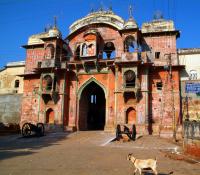 I arranged for a boat ride in the morning soon after sunrise. My little guide thought I wanted to see the sunrise itself but I made it clear to him that this definitely was not my objective. I did not fancy getting up at 5 a.m. So I agreed to meet him at 7 o'clock.
I arranged for a boat ride in the morning soon after sunrise. My little guide thought I wanted to see the sunrise itself but I made it clear to him that this definitely was not my objective. I did not fancy getting up at 5 a.m. So I agreed to meet him at 7 o'clock.
When I got on the boat, something rather shocked me. I saw people searching the banks of the Ganges looking for jewellery of the cremated deceased. I was told it was rather easy to find it since many people are cremated with their jewellery and many of those items can be found on the market later on. How ghastly!
The maharaja palace in Ramnagar is best viewed in the setting sun, from the Ganges and not in the morning when I came. I quickly regretted not having gone there the day before when I had a chance. The sun was shining directly into my eyes and I could not appreciate the view. The front of the palace however looked great though. I did not plan to visit Ramnagar, however the little guide of mine convinced me.
He lured me with the best lassi in the state of Uttar Pradesh. The vendor was using only milk, as opposed to many others who blend water in, and the drink was so thick that it was served with a wooden flat stick so the lassi could actually be eaten. It was lovely I have to say. I was a little concerned about my gut since the drink was served in a ceramic unpainted upside down cone, and I had no idea how clean it was.
Well, I could only just sit back, relax and wait what was going to happen. My stomach is not very sensitive anyway and the little open-air bar was situated right at the main gate of the maharaja's palace.
The Varanasi side of the river is used almost exclusively by men for bathing and similar rituals, including washing. Women use the other side of the Ganges, which also happens to offer a great beach. Women are shipped in sever dozens at a time in large rowing boats from Varanasi to the other bank. And when they finish their business, they are shipped back. This is how it has worked for thousands of years.
I also found out that women were not allowed at the main cremation ghat, Manikarnika. Two reasons: 1/ they often throw themselves into fire after their husbands and 2/ they cry too much and thus disturb the soul to transfer itself into the nirvana. For the Manikarnika ghat is believed to be the only place in India with direct corridor to nirvana. That is why people would travel miles and miles to cremate their loved ones there.
The little guide insisted that I went to see his shop. He worked there and if I bought anything he would get 2 percent commission. I only bought two little silk scarves. The boss was insisting that I bought more and I told him that I had no money. He simply said that I should use my credit card. I was getting impatient with that and asked him who would pay the credit card bill once it arrived? I also told him that I do not spend money on things I do not need, because that is really silly.
He still insisted so I let him show me stuff but simply refused to buy anything more. He must have unpacked half of his shop. I did not care at that point.
I got a little nervous when I was going back to the airport. The traffic was so bad that there are no words to describe it. On a selection of completely chocked crossings, which were in fact collision-free roundabouts, policemen stood. My guess they were there to control the traffic, but amazingly they actually allowed for this ultimate chaos. My taxi driver was not very clever and allowed many cycle-rickshaw and autorickshaw and motorbikes and bicycles and motor vehicles to squeeze in front of the taxi. I was so not amused.
I made it on time though with time to spare for a beer and papadums, which I enjoyed at the airport restaurant.
|
Oct 05, 2006 02:00 PM Varanasi (Uttar Pradesh)
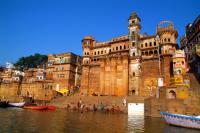 While Agra beamed with Islamic way of life and architecture, Varanasi could not even try to be more Hindi. The holy city and the arguably the oldest one in the world is strikingly Indian with the Ganges river flowing through it carrying semi-cremated bodies of the deceased, washing detergents and soap, as people bathe in the river, and flower offerings floating on the surface. I think it is Damascus of Syria, which claims to be the world’s oldest city, which remains constantly populated and active.
While Agra beamed with Islamic way of life and architecture, Varanasi could not even try to be more Hindi. The holy city and the arguably the oldest one in the world is strikingly Indian with the Ganges river flowing through it carrying semi-cremated bodies of the deceased, washing detergents and soap, as people bathe in the river, and flower offerings floating on the surface. I think it is Damascus of Syria, which claims to be the world’s oldest city, which remains constantly populated and active.
When I arrived I was shocked by the price of the taxi ride from the airport. It cost me 520 rupees almost as the city was 50 kilometres away. It was not.
As soon as I rolled in slowly to the centre, I was confronted with a picture of a completely overcrowded Indian city suffering from sticky heat and a traffic jam beyond belief. I guess National Geographic Channel might have shown Indian cities like that and given the status of this city, it certainly could have been Varanasi.
The taxi driver cheekily asked me for a tip, although it is customary not to tip taxi drivers. He put me down diagonally across a busy crossing from my hotel. I had to risk my life, like all other pedestrians there, and cross over.
As I was walking towards my hotel, a guy spotted me doing this and showed me a business card of the hotel where I wanted to stay. That was not hard, since it was the only hotel in the nearest vicinity. He kept repeating the hotel name and made hand movements as though he was directing me to the hotel. There was no need for that since the hotel and its pure vegetarian restaurant were clearly sign posted.
When I stepped into the reception area he was still there and the receptionist immediately asked me who he was. I said that I did not know and after seeing a room, I stated with crystal lucidity that he was a crook trying to extort money by demanding commission for bringing me to the hotel. I explained how I found about the hotel and that a taxi brought me here directly from the airport.
My room was not ready. So I sat down in the restaurant by the window, ordered beer, some traditional Indian dish for lunch and watched people in the busy street below. So far I was happy.
In the meantime, the hotel informed me that my room was ready and asked if I wanted to have lunch in my room. I said was quite happy in the restaurant. The fan behind me was not the quietest in the world but delivered nice cool air right in my back. I was making plans for the rest of the day while typing these words.
Every now and then, a cycle rickshaw would pass in the street carrying a tourist. Sometimes, a group of inhumanly overweight American girls would stroll examining the colourful robes hanging from the little shops' marquises. The day appeared slow. Not because of the horrific traffic but the overall animation of the street. I almost regretted that I was not part of it. I was still waiting for my food. I knew very well that it was too early for photographs as the sun was still too high. Yet, I kind of wanted to be there in the town, perhaps riding in the rickshaw and soaking the atmosphere of this holy city.
Actually, nowhere else in India it felt so hot and humid. Sweat was running down my back giving me the pleasure of wet pants. It is a funny feeling that you know exactly where on your back it will find the way to your underwear, is it not?
The air conditioning did not work in my room for the whole afternoon as Varanasi was cut off from power. The hotel provided however fans which got power from truck /lorry batteries, which happened to be piled up right outside my room. First, I did not know what they were for, but then when the chamber-boy, officially known as floor boy, explained the lack of breeze in my room, I understood. How funny, I thought, that the idea of power generator fuelled by petrol was not popular in Varanasi. I noticed many people transporting similar large vehicle batteries around.
The best and almost the only way to see the ghats is from the river. I figured that from the many pictures I had seen of Varanasi. And so, after quick refresh in my room, I headed down to the Ganges. There was absolutely no problem whatsoever to arrange a boat trip. I negotiated one with an impossibly skinny young lad. He charged me 850 rupees for one hour ride.
When I travelled up the river the sun was against me and I could not take good pictures. I soon turned the boat around and floated with the current down with the sun behind me. The light was good although I think I should have taken the boat an hour earlier. The sun was getting too low behind the buildings, which therefore looked dark in their own shadow. This is how it looked from the river, at least.
Two small boys insisted to join me on the boat. I think they might have been brothers of the stick man who gave me the ride. They played a little on board and then fell asleep. Typical!
I knew that I wanted to make another trip on the Ganges in the morning to see the ghats in a different light. And I wanted to see the last palace of the maharaja of Varanasi, which was located at the other side of the river, in Ramnagat.
I thought that the little guide, who insisted to accompany me on my Varanasi adventure, might have been a mistake. I was wrong.
The ghats are not easily found on the first day and the old part of Varanasi is a complex system of very narrow and dark alleys making it a medieval labyrinth hard to navigate. At night it was even harder. I saw that many tourists took guides with them, purely as a navigation tool.
The Manikarnika Ghat is the main ghat in Varanasi. My guide called a ‘burning ghat’. It used to cremate the deceased. It costs 250 rupees per kilogram of fire wood for cremation and 200 kilograms is usually needed per person. Apparently poor families collect money from families who can afford to cremate their deceased relatives, each would give for one or two kilograms. Eventually there is enough money to pay the one man in Varanasi who controls the trade of this special fire wood. The wood allegedly comes from 700 kilometres away.
The moon was very strong. It was not even full. Yet its light reflected in the holy waters of the Ganges, which seriously surprised me. As the evening went by and I sipped my beer high on the terrace of the Dolphin restaurant, located above the A Palace On River Rashmi Guesthouse, the little candles started to appear on the surface of the river. They kept floating one by one, like in the movies.
Little I knew that I arrived on the third day of the festival of the ten arms goddess Durga. My guide insisted I went to see the ceremony.
I was placed right in the front row of the spectacle. Young guys performed a ritual involving blowing a horn, dancing, burning incense, lifting bras containers filled with fire and throwing flowers into the river.
Then the incredibly packed streets full of worshipers, onlookers and idiots on motorbikes turned into rivers of crowd carrying the statues of the goddess Durga. Music played and magicians chanted. There were mainly drums that broke the air filled with holy smoke. I felt lucky to experience the festival. It filled the city with fabulous spectacle, spirit of joy and celebration, and made my short stay unforgettable.
A combination of staying in a hotel on the main street and the festival also meant that I could hear the loud celebrations all night long. Indian music mixing new trends and traditional rhythms was blasting from massive speakers. Occasionally, a loud explosion pierced the air accompanied with bright lightning. The road at which my hotel stood led directly to the main ghat where the statues of Durga were thrown into the Ganges.
I surprised myself that I actually managed to fall asleep at some point in the night.
|
Oct 04, 2006 02:00 PM Delhi - again in the federal city
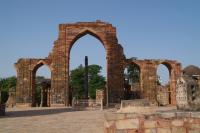 In the morning, I overpaid for my hotel again. I paid according to the tariff but the value for money it was not. When I got on the allegedly government taxi which used a taxi meter, I knew that I should have tried to visit Qutb Minar the day before, as I landed from Varanasi.
In the morning, I overpaid for my hotel again. I paid according to the tariff but the value for money it was not. When I got on the allegedly government taxi which used a taxi meter, I knew that I should have tried to visit Qutb Minar the day before, as I landed from Varanasi.
The taxi from the Connaught Place to the monument cost me already 580 rupees, compared with 250 I would have paid for a private taxi ride or 150 if I have taken a prepaid one. I naturally thought I was being ripped off. I asked one of the guides and guards at Qutb Minar if what I was about to pay was reasonable. They were shocked and told me that I should have paid about 250 rupees only. Both of them and some other people, who tagged along, accompanied me to the taxi, which was waiting to take me further to the airport. They all called the taxi driver a cheater.
They told me that I should only pay him 600 rupees when I get off at the airport. The taxi driver switched off the meter, and started complaining about the fact that he was called a cheater. He said that he could take me to a police station so they would check the meter. He also called his boss and asked him what to do. They asked me. I said that I had no time and needed to be taken to the airport as soon as possible. The traffic was horrendous and I did not fancy wasting time on the police, etc. At least I was illuding myself that the meter might actually have been correct and I simply should have not taken this cab. I did not care that much anyway. The ride was costing me about 10 pounds, which by European standards was rather cheap.
Qutb Minar was somewhat a magical place. It was old. The minaret was great, although the monuments surrounding it were badly ruined. I liked the park there. It was very well maintained and had a lot of shaded areas to sit down and relax.
The famous and mysterious Iron Pillar looked like it did not fit there. It is in fact one of this world’s greatest mysteries. The iron, of which the pillar was made, is of exceptional purity and to date, science is unable to explain how this pillar could have been cast.
|
Oct 03, 2006 02:00 PM Agra (Uttar Pradesh)
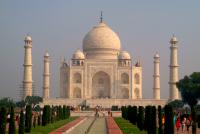 The train from Delhi to Agra was very comfortable and made the 169 km journey in about two and half hours. The service on board was also good. Complimentary breakfast was served complete with corn-flakes, vegetarian falafel, biscuits, tea, water and good quality newspaper, which all kept me busy for the entire trip. Comfortable reclining seats with plenty of leg room and efficient air conditioning were not exactly the experience I was expecting from Indian railways.
The train from Delhi to Agra was very comfortable and made the 169 km journey in about two and half hours. The service on board was also good. Complimentary breakfast was served complete with corn-flakes, vegetarian falafel, biscuits, tea, water and good quality newspaper, which all kept me busy for the entire trip. Comfortable reclining seats with plenty of leg room and efficient air conditioning were not exactly the experience I was expecting from Indian railways.
When I arrived in Agra, I spotted a prepaid taxi booth, which listed prices also for complete day trips including Fatehpur Sikri. Those cost 1,400 rupees and I thought I should take such trip.
A local businessman spotted me and said that he had a good air conditioned Honda. I asked him to show me the vehicle. I liked what I saw and said that I could make an arrangement bypassing the prepaid booth. A guide tagged along and I think he expected to be paid.
I ordered Taj Mahal as the first stop hoping to catch the gentle light of the early sun, and perhaps smaller crowds. It worked! The shadows were still long and the gentle haze in the air made the monument appear as it was floating in the air magnificently. The crowds were only just cumulating.
The Taj Mahal was built of translucent marble from Jodhpur region, which contains minute crystals allowing the light to pass through the stone. This makes the entire structure appear very light. And as the strength of the sun rays changes during the day, the marble glows differently.
Apparently the building turns blue in moonlight and red in the setting sun. I was not visiting Agra long enough to experience those views, so I could not verify.
The rules of symmetry in the Islamic architecture had a peculiar effect on the complex of Taj Mahal. The ruling Mughal requested a mosque to be built on site. However, the structure of the mosque would create asymmetry and exactly the same building had to be erected on the other site of the Taj Mahal. It was used as a guesthouse.
Entry to the Taj Mahal park is restricted. Tourists and locals must pay the entry fee and most electronic items are banned, including iPods, mobiles, games, and torches. Yet, the mosque beside the Taj Mahal is fully operational and I was wondering how would people be able to afford to come and pray there.
A system of a gold-card or pass was introduced to deal with the problem. Muslims can obtain such a card and then using is as a pass, they attend the mosque inside the park.
I was told that some 15 years ago the entry to the park, which is surrounded by red sandstone walls, was free.
Many writers and poets have attempted to describe the magnificence of the Taj Mahal and although it is a truly remarkable building it had dubiously anything to do with love. The Emperor Shah Jahan comissioned the construction of the mausoleum to the memory of his second wife Mumtaz Mahal. He spent a fortune on this project, which is said to have cost over 3 million rupees at that time, an equivalent of 60 million euro today. This extravagance made his son suspect that the Emperor lost his mind. The thing was that Mumtaz Mahal actually asked his husband to built this tomb for her. She also forbade him to remarry.
Then the Emperor was imprisoned by his own son, who did not agree with the idea of building another Taj from a black marble.
Taj Mahal looks almost new despite having 356 years. It is clearly to do with the quality of the marble, which is washable. Every year, the monsoon washes Taj Mahal and no other maintenance is needed. The semi-precious stones are embedded in the marble and are washed along with the marble. It is rather impressive how it was done.
My guide insisted that I went to see the family who are the descendants of those Persians who decorated the tomb. The Emperor ordered that thumbs of the decorators were cut off so they would not build anything similar later on. And he forbade them to leave the country. So they remain in India. The family is not allowed to pass the technique to anyone else, which I found completely unbelievable. It is not a rocket science and they do show off with the workshop a lot, so it is very easy to imitate.
Today, they make mainly marble tables, plates and jewellery boxes. All decorated in the same way as Taj Mahal by embedding semi precious stones in. Then, I knew why the bastards, the guide and the driver, took me there. They did not want me to see the workshop. They wanted me to buy things there so they could hey their commission. I told them off quite angrily. Yet, they insisted that I went to see also the carpet shop and a jeweller. As I had time to kill, since most historical venues closed at 5.30 p.m and my train was leaving at 8.20 p.m., I agreed. And furthermore, I bought a small rug and a few pieces of jewellery.
Agra fort, which I saw after Taj Mahal, is amongst the largest defensive structures I have ever seen. It is also one of the most elaborate, containing palaces and mosques within itself. From the rooms and flanks facing the river, Taj Mahal looks like a mirage. A wonderful view.
The red walls of the fort appear to be running for miles without end, since most view points do not allow to see the end of the wall. The palaces and mosques were built with the same marble as the Taj and also decorated with the same technique of embedding precious and semi-precious stones in the marble.
Agra is a tax free zone. A few years back, the government decided that industrial pollution damages Taj Mahal and so they removed all factories from the area. This resulted in a few thousand people losing their jobs overnight. Following major protests from the Agranians the government ruled that the people would be exempt from taxes provided they took up handcrafting. It is therefore said that hand-made items in Agra cost approximately 30 percent less than in rest of the country.
Poverty is extremely visible in India. Millions of people have no homes and simply live on the streets. Entire families live on the streets. They sleep on the concrete pavements, sometimes half naked, and sometimes even on the road. When I was walking back from the train station, it was about 10.30 p.m., I had to navigate between bodies scattered around making sure I was not going to step on anyone. It was dark so I really had to be very careful. Small children sleeping on the curbs were particularly hard to spot in time.
Many children live on the train stations. They are called station kids. They wander around the platforms and along the tracks. They beg for money and food. Many passengers do not give them anything. And many of those children are very small, perhaps four years old and still they carry their younger siblings in their arms.
I actually wanted to point that finding the right train and the right platform was very easy. The current information was illuminated on electronic boards with clear indication where your train was going to be. Yes, occasionally you need to know your train number but without it you would find it hard to make a booking in the first place. On the Agra Cantt station, the coach numbers were illuminated in places where they each coach was going to stop. Wow, and modern!
|
Oct 03, 2006 02:00 PM Fatehpur Sikri (Uttar Pradesh)
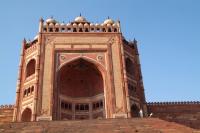 The abandoned wonder city of Fatehpur Sikri, built by the first Mughal great emperor, Akbar, is an intriguing site. It was made a perfect city and then abandoned due to shortages of water. There is no natural reservoir or a river nearby, but now two villages surround the ruins and they prosper well. One is called Fatehpur and the other Sikri.
The abandoned wonder city of Fatehpur Sikri, built by the first Mughal great emperor, Akbar, is an intriguing site. It was made a perfect city and then abandoned due to shortages of water. There is no natural reservoir or a river nearby, but now two villages surround the ruins and they prosper well. One is called Fatehpur and the other Sikri.
The remarkable architecture of the city must have taken breath away from anyone who visited the then capital of the Empire. One of the gates to the fortified mosque, which is still in use, remains the tallest and grandest gate in India! See picture above.
UNESCO inscribed the city as a World Heritage site and rightly so. It is unique. The splendid urban planning was unprecedented at that time and the combination of the imperial palaces and quarters with areas for public use was remarkable. And the public places were equally striking as the royal residencies.
The site was again full of vendors selling rubbish. They all had the same things to sell, beads, postcards, small boxes, marble carvings, etc. All of terrible quality. They would follow me around insisting that I bought something and that I was their first customer that day. Right! They just would not leave me alone. I had to ask them why they were insisting as I had already said 'no' five times.
I went to Fatehpur Sikri at the end of the day as the sun was preparing to go to bed. This gave me superb lighting conditions for those few photographs I took there. To my astonishment I spotted a small boy pulling up buckets of water from the well located in the main courtyard of the mosque. I could not believe that well was still operational.
As I was returning to Agra, I passed through small towns and villages but the scenery of the countryside was nothing special. I think one can see similar landscape on almost all continents, even in Europe, particularly in the rural areas of Romania. The roads were paved and I did not feel I was in India at all. It simply did not feel exotic. The only distinguishable element of the street life were women wearing typical Indian robes.
|
Oct 02, 2006 02:00 PM New Delhi (India)
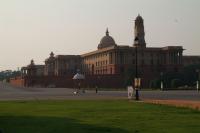 From the mosque I took an autorikshaw to the India Gate. It is a large arch built to commemorate Indian soldiers who gave their lives in the World War I. I walked in the park along the Rajpath, India's response to Champs Elissee in Paris. It is a broad alley complete with parks that run at both of its sides. It starts from the National Stadium, passes India Gate and runs to the Rashtrapati Bhavan, the President's House.
From the mosque I took an autorikshaw to the India Gate. It is a large arch built to commemorate Indian soldiers who gave their lives in the World War I. I walked in the park along the Rajpath, India's response to Champs Elissee in Paris. It is a broad alley complete with parks that run at both of its sides. It starts from the National Stadium, passes India Gate and runs to the Rashtrapati Bhavan, the President's House.
The strange, museum-like buildings, which were built in 1929 combine the local Mughal and classical Western architecture styles. They very much resemble the government buildings in Pretoria, South Africa.
On the top of the government hill, an autorikshaw spotted me and asked me if I were interested in an afternoon trip around a few sights nearby. I told him that I normally would but I was aware that everything was closed. He insisted that some places were open. He showed me postcards of those open places and I noted that the only place I wanted to see in Delhi was supposed to be open in fact. One other driver told me that it was closed.
It was the UNESCO World Heritage Site of Humayun's Tomb. Built in 1550s it represents the finest example of early Mughal architecture and it looked superb in the light of the setting sun. The park also contains a great example of Lodi architecture, an octagonal tomb of Isa Khan. And I have no idea who that was.
The perfect symmetry of the Humayun’s Tomb and the architectural ideas were almost entirely re-used, and obviously perfected, at the Taj Mahal in Agra. The central dome, the large arcaded central entrance and the small arcaded walls and levels, all put together in perfect proportions, creating an elegant and elaborate structure. It is a masterpiece! And even today, half a millennium later, it looks perfect and almost new.
Then, the driver took me to the Lodi Garden, which is a palmtree-lined park containing tombs of Sayidd and Lodi rulers, who lived between the fifteenth and sixteenth centuries. I only spent a few minutes there.
After that the driver insisted that I go and visit two shops, so he could earn his commission. I told him that I would want to see a Hindu temple first as the sun was going down fast and I still wanted to take some pictures. So he took me a few hundred yards from the park to a Hindu temple, decorated with swastikas. The temple was very small and it was busy getting ready to receive the worshippers. Something was telling me that it was not the temple I thought he had shown before on the postcards, but I did like it a little, so I did not care. I saw the Humayun’s Tomb!
So, I agreed that I would go and visit the shops. I knew that I was not going to buy anything there. I actually would not anyway, since the quality of stuff they sold in those bazars was not the finest. Wait a minute! Actually, I do not have to be politically correct in my stories. I will state it clearly then, that the quality of all the items (ranging from jewellery to textiles, to pottery, to bras work, to wood carvings, to carpets) was rubbish and shit.
I ordered the driver to take me back to my hotel.
At the end of my day I sat down on the terrace of my hotel and had a couple of beers while watching fireworks going off in the old city. They were for Ghandi. And it was a good conclusion of my day.
The next time I was in Delhi, I thought I ought to try to see the mysterious Iron Pillar at Qutb Minar. However, my flight from Varanasi was almost half an hour late and my plans were shattered. I had to head directly to the hotel.
Already in the taxi I was speculating what I should have for dinner at the Chinese restaurant near my hotel. I was thinking I should have noodles for a change and perhaps Sichuan chicken. I was almost hoping that they might even do a Thai dish. My, oh My, how happy I was to find a Thai Prawn Curry on the menu when I got there. It even came with complimentary beer and rice. I forgave myself having rice since I was eating Thai. I still treated myself to two appetisers of prawns. Why not? I knew as I passed through the door that I was going to pay with my credit card! I splurged!
The pepper prawns were great but the Thai curry was not. I should know better that non-Thai restaurant, and definitely a Chinese one, would have no clue how to make a proper Thai curry. Well, this one resembled it slightly in taste but the devilish orange colour was a little too odd. Even for my excitement that evening.
After dinner I went for a quick walk around the circular Connaught Place. It looked much better at night. The posh designer shops were open, which made the area appear more civilised. I passed a few nice shops all equipped with a doorman, which would not allow you touch the door. They wanted to open and close it for you.
|
Oct 01, 2006 02:00 PM Old Delhi (India)
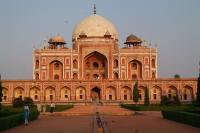 When I arrived I quickly got my prepaid taxi to the center and with surprising ease I found my hotel. As I approached the hotel, a French couple struggled in a conversation with a local guy. They were quite desperate to find a place where they could have some breakfast. He was trying to explain to them that as it was the 2 October, Ghandi's Birthday, it was a public holiday and the majority of business would be closed. At least in the morning.
When I arrived I quickly got my prepaid taxi to the center and with surprising ease I found my hotel. As I approached the hotel, a French couple struggled in a conversation with a local guy. They were quite desperate to find a place where they could have some breakfast. He was trying to explain to them that as it was the 2 October, Ghandi's Birthday, it was a public holiday and the majority of business would be closed. At least in the morning.
They were ecstatic when I suggested they could accompany me to my hotel where they might have their breakfast. They did.
And so did I. I went for a glass of orange juice and tomato omelette. The latter was fine but the juice was not. I was wondering whether my stomach was going to protest later.
Monday is probably the worst day of the week to visit the capital because almost everything historical worth seeing is closed. When I arrived I had double closing effect since it was a public holiday too.
I was not sure what to do with myself so I wandered a little around the Connaught Place, an elaborative piece of architecture meet traffic solution. It is a three layer traffic circle of almost one kilometre in diameter. It has the main circle, the middle one and the inner one. Between them there are residential and commercial buildings complete with classical columns and arcades along the entire length. There is also a room for a park, in the exact middle of the inner circle, underground shopping centre and a metro station. The metro station, to confuse the traveller, is not called Connaught Place! The circle is a form of a junction between Old Delhi and New Delhi.
A young guy from Kashmere started talking to me as I was standing by one of the posher shops. I thought he wanted to sell me something and I think he did, but he later denied it. I asked him about the metro station and where it was going from there, and he told me that it would take me to the Red Fort, so I left him and went down underground.
The metro was new and it was mega clean. Not many people were using it that morning and I could deduct that its popularity was still in its infancy, since the authorities could afford taking time to process every passenger through a metal detector and to search luggage.
The metro system was rather simple. It had three lines and it was quite easy to navigate. Both the stations and the trains were spacious and well maintained. I liked it. The only problem I had with it was that the stations were not sign posted on the ground and it was very hard to find the right hole in the ground!
When I made my way to the fort I still did not know that it was closed. So I just made a complete circle around it passing through some very poor and dubious living districts. I took a few pictures of the fort's red walls and made my way back to the old town.
I wandered a little without a destination in mind for a while. And even when I decided on a course to take I took much longer way since I had no map and many streets were blocked by the police due to the Ghandi festival. I could still have taken them, since they were closed for vehicles only.
My course was for the mosque, the Jama Masjid built in 1658. Its main courtyard can hold 25 thousand worshippers. It has a majestic dome, grand gates and two 40 meters high minarets.
|
Sep 30, 2006 02:00 PM Jaipur (Rajasthan)
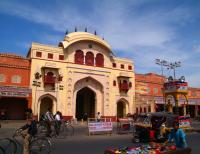 The area where I was staying was surprisingly green. Mainly Acacia trees lined the alleys. So when I entered the old town, I realised that it was in fact the pink city as Jaipur is nick named.
The area where I was staying was surprisingly green. Mainly Acacia trees lined the alleys. So when I entered the old town, I realised that it was in fact the pink city as Jaipur is nick named.
Many buildings within the city walls were painted pink for the visit of the Prince of Wales in 1876. Since then they have been repainted regularly. For kilometres buildings along the main streets are painted in the same shade of pink, which makes Jaipur stand out as the undeniable pink city. An odd gate in the city inner wall painted cream or white makes a fabulous contrast. Or Jaipur oldest minaret of cream colour too, stands out beautifully.
Jaipur palace was striking! It was really well maintained and its architecture was great. Excellent were the decorations on the walls and particularly the doors and door frames. At one of the palace courts two silver jars stood. They were the largest single silver pieces in the world!
I just walked around snapping pictures like crazy. It was a good day already I thought although it was still before noon!
The next thing I went to see were the giant astronomy tools completed in 1901. They were erected before but corrected and restored in 1901. I thought it was nothing special maybe because I could not stand the crowds. As it was weekend, many Indian tourist groups augmented the number of visitors in this very small park. I agree it was somewhat unusual, but not very pretty.
I got away from there quickly and went to the see other parts of the old town. I particularly loved the famous five storey honeycomb pink facade of the Hawa Majal built in 1799 for the women from the royal court. Through those honeycomb windows they could watch the street life.
I also admired some of the seven gates to the old city. My favourites were the Moon Gate, the Samrat Gate, the New Gate, and the Ajmer Gate. The gates leading to the City Palace were also splendid.
The driver also took me to the royal tombs at the Royal Gaitor. The cenotaphs built there for the maharajas were richly decorated in meticulously carved white and cream marble. They all had domes some of which were supported by beautifully carved pillars.
I also saw the cenotaphs of the majaranis and the nearby Jal Mahal, the palace on water. It was constructed as a summer residence for the royal family. Today, the maharajas would not enjoy their stay there due to the foul stench. The lake stinks beyond belief and fortunately plans are being made to clean up the reservoir which is home to some migratory birds. The palace is dubbed to be converted into some tourists orientated object. Yet, the lake has to be cleaned first!
Traffic in Jaipur was mad. To be able to drive, one just needs three things: working horn, good brakes and luck. It seems that anything else, including driving licence, were optional. No-one was ever looking around to see if it was safe to enter the traffic, turn or overtake. Everyone was extremely bad at it. I was therefore not surprised to see a dead pedestrian run over lying still on the street. I could not see whether it was a woman or a man, young or old, as people gathered and sat around the victim creating even larger traffic hazard!
I went back to the hotel to refresh and relax a little. My room was clean and cool. I decided to go downstairs and have late lunch in the garden. It was a good move.
The kitchen served only vegetarian dishes so I went for the potato curry. It was delicious, and plenty of it. So plenty, that I felt like snoozing after the meal.
I went back to my room with a plan to have a nap and then go and see the old city at night. They were a few restaurants and bars, which I was considering visiting. If only for a drink. I even thought I could go to the cinema! Well, when I got up from my nap, it was 9 p.m. - too late for anything!
On the airport they removed rechargeable batteries from my hand luggage. I was unamused since in Mumbai and Udaipur the batteries were not a problem. Had I known this would be the case I would have put them with toiletries in my checked-in bag. It was such an inconvenience to try to track them down on arrival. They did not confiscate them but kept them away from me at the crew compartments. I was supposed to contact the ground staff in Delhi and collect the batteries from them. Such a waste of time, I thought.
|
Sep 30, 2006 02:00 PM Amber (Rajasthan)
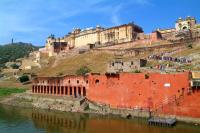 I decided to visit the Amber Fort first. Its size truly impressed me. From where I stood it definitely looked like it had never been taken. Not only did the fort looked massive but also the defence walls spread onto the adjacent mountains a few miles away made this scenery incredible.
I decided to visit the Amber Fort first. Its size truly impressed me. From where I stood it definitely looked like it had never been taken. Not only did the fort looked massive but also the defence walls spread onto the adjacent mountains a few miles away made this scenery incredible.
The fort was built as an official residence and the capital of the Rajput clan of Kachhwahas in the 12th century. The family of these rajputs ruled in the area for eight centuries. What they created there as their palace is a true masterpiece. Parts of the fort look very delicate - so this is the palace section, built from white marble and red and cream sandstone. And parts of the gigantic structure was doubtlessly made to look war-like with layers of defence walls.
Intriguingly the complex contains also the Temple of Kali. Like in the Indiana Jones film. However this one was not deep under ground and was not connected to an underground lava flow.
The ascent from the main road to the palace was gentle but littered with beggars and genuine worshippers who wanted to visit the other temple inside. The flow of those visitors was more tiring than the ascent itself despite the fact that I was making it at high temperatures in full sun. Some of the beggars were unluckily disfigured, had something wrong with their arms or legs and as they were very dirty it look awfully disgusting.
At the bottom of the palace there was a small pool of water where elephants were taking their bath. I was not sure what think about those elephants. They were hardworking and looked very unhappy. Well, they were clearly out of place. They should be in the jungle and not on the desert. The heat must have bothered them enormously. Also they had to walk all the 32 kilometers on the black burning hot tarmac everyday to and from Jaipur. The mahouts who take care of the elephants cannot always afford to provide appropriate living conditions for the animals. The creatures' feet burn and split by walking on tarmac, their skin is sunburnt and they lack vitamins, which leads to blindness and rotten feet.
My dilemma was weather I should go on the elephant ride and provide a mahout with some money to treat his elephant. Or should I avoid it demonstrating that I sympathise with the creatures discouraging the mahouts from doing the business there. It would be so much better if the elephants worked in the jungle in their natural climate. The hot and dry Jaipur and vicinity would need to do with the camel rides only. So I did not go for an elephant ride after all.
I just took a few pictures of these gentle and graceful giants having a dip in the water. Some of them were receiving a proper scrub from their caretakers. It was so obvious that they just loved it. That was a good picture! Some of them submerged themselves completely with only a trunk sticking out for breathing. One was playing with its trunk splashing water around. I must have stood there for about an hour watching this. It was a great spot. Apart from the fact that I had to say about a thousand times ‘no’ to petty vendors and beggars, or kids wanting their picture taken for a modelling fee.
|
Page:
 64 65 66 67 68 69 70 71 72 73 74
64 65 66 67 68 69 70 71 72 73 74

|
|
|
